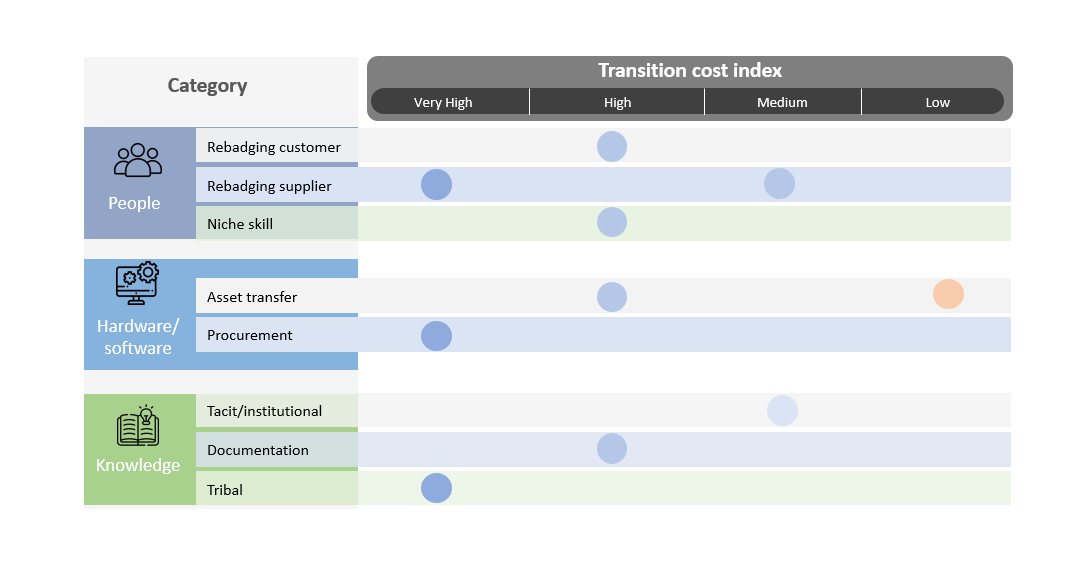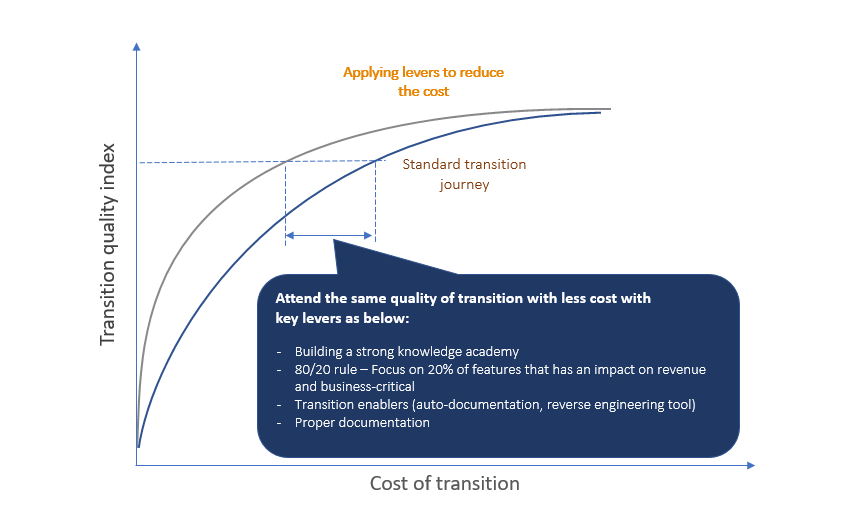Transform to Net Zero-Cost Strategy – Debunking the Myth and Optimizing Costs
IT costs have become increasingly difficult to control as organizations have become more dependent on IT infrastructure. The digital, fast-paced, and fiercely competitive world has made cost optimization a key priority for organizations seeking to maximize operational efficiency. During the knowledge transition process from one part of your business to another (e.g., customer to a new supplier, or incumbent to a new supplier, etc.), there is usually a lot of discussion and debate about the cost involved. As transition costs make up a substantial share of the total expenses of the total contract value (TCV), understanding the importance of cost containment during the transitioning period is critical, whether from customer to supplier or supplier to supplier. Reducing operational costs is a significant driver for most outsourcing needs.
A net zero transition is a type of migration that allows organizations to move to a new system without incurring additional costs. This blog aims to delve into the complexities of transition costs for both Information Technology Outsourcing (ITO) and Business Process Outsourcing (BPO) – related projects.
While the goal is to achieve zero transition costs, it is essential to strike a careful balance between short-term and long-term benefits, considering the magnitude of the task. In this blog, we will explore the factors that influence transition costs. We will also discuss the challenges involved in reducing transition costs. Finally, we will identify which expenses should be reduced and protected to drive growth and efficiency, even during the transition phase. By understanding the intricacies involved, organizations can unlock new avenues for growth while effectively managing their operational expenditures.
The influencing factors – Understanding transition costs
We have categorized critical parameters based on their nature and magnitude of exposure to transition costs. This will give stakeholders valuable insights into the factors that influence these costs. While this list is not exhaustive, it is a guiding framework for understanding and addressing the elements at play.

Figure 1 – Impact of various parameters on the cost structure of transition
*Rebadging – where the customer is ok to rebadge or rehire a certain percentage of their key SMEs as part of risk mitigation
*Niche skill – the cost of a consultant for niche skill is high
*Asset transfer – when there is a need to transfer asset software hardware from a customer or existing incumbent organization and any need to procure new software license etc., to support the services
*Tacit and tribal knowledge – scenarios where knowledge, skill, abilities, etc., are gained over experience and supporting systems for a very long period, which are often not available in any form of documentation.
- People – The overall staffing strategy significantly impacts cost optimization. However, there are limited levers available in terms of cost optimization. The cost of rebadging customer Subject Matter Experts (SMEs) tends to be higher than rebadging supplier SMEs. Location strategy also plays a role, as the price of rebadging onshore SMEs is typically higher than offshores. Cost arbitration during the transition period is minimal. However, post-transition avenues such as onshore-offshore rationalization and pyramid correction can contribute to further cost reduction in operations.
- Hardware or assets – Infrastructure, hardware, and software form another critical element. When there is a need to transfer asset software hardware from a customer or existing incumbent organization and procure a new software license, etc.
- Knowledge base or transfer – Knowledge transfer from one individual to another is crucial to the transition process. This area presents opportunities to employ levers and best practices to contain costs. Remote transition methodology and accelerated transition frameworks help reduce the transition cost.
With this understanding of the influencing factors, we will delve into key levers and practices to help us achieve our net zero transition goal.
Transition costs – Approaching the objective with discipline
In considering the financial impact of transitions, it is essential to remember that there are ways to overcome these challenges. Achieving a net zero change requires cooperation between customer and supplier stakeholders, bringing disciplines together by establishing a robust knowledge management framework. Here are some key elements that various groups can focus on to foster a more organized and optimized transition.

Figure 2 – Cost vs. transition quality
- Emphasize proper documentation – Building a strong knowledge academy framework can be crucial in containing transition costs. Lack of system documentation often results in increased outsourcing costs for customers. This requires additional efforts in compiling new Standard Operating Procedures (SOPs) and running books and investing in evaluating and implementing reverse engineering software and tools. Establishing a well-defined process and incentivizing periodic updates to documentation helps contain future transition costs while reducing dependency on resources for knowledge transfer.
- Apply the 80/20 rule – Not all components in each landscape are equally crucial or unstable.
In times of transition constrained by time and cost, it’s vital to prioritize areas with frequent incidents, tickets, or issues, as well as business-critical features. These components typically constitute about 20% of the landscape. Instead of aiming to cover the entire 80%, which may not be essential for comprehensive transition coverage, this targeted approach is key.
- Leverage transition enablers – Optimize transition processes with the help of transition enablers such as LTIMindtree’s TransEdge tool, which facilitates transition management. Additionally, benefit from tools like TransEdge Analyze for portfolio landscape analysis, TransEdge Dashboard for real-time persona-based insights, TransEdge Ready Reckoner for corrective actions and mitigations, and TransEdge Audit for assessing transition health. Enhance efficiency further by employing accelerators like reverse engineering, macros, and scripts to automatically document application functionality.
- Transition risk forecasting – Mitigate risks and proactively address issues by establishing a continuous risk assessment process. Correcting problems during transitions often leads to higher costs, so identifying and managing risks in advance is crucial for cost containment. Robust multi-layered governance with a dedicated focus on reviewing major risks periodically helps in mitigating.
- Consider customer maturity – Evaluate whether the customer is a first-generation or second-generation outsourcer. The maturity level of customers plays a significant role. Proper planning of familiar transition blocks such as onboarding, access provisioning, and network connectivity can effectively keep costs under control for customers already experienced with outsourcing.
Conclusion
While achieving a zero-transition cost is not completely a myth, optimizing transition costs is possible. By doing so, we can ensure a smooth transition, drive profitability, and set the stage for sustainable growth. It’s essential to remember that the transition duration is just a small portion of the overall journey. Rushing into risky decisions for short-term gains can prove detrimental to long-term profitability. By carefully balancing the need for efficiency and financial prudence, organizations can navigate transitions successfully and reap long-term benefits.
Cost optimization is a continuous process that requires careful consideration of the overall journey and balancing short-term and long-term objectives. Transition costs are not insurmountable obstacles. With a thoughtful approach, organizations can unlock the potential for a successful transition while maximizing value and minimizing unnecessary financial risks.
More from Om Mohanty
Introduction Knowledge is a paramount asset in any organization. Specifically, within an IT…
Latest Blogs
Introduction What if training powerful AI models didn’t have to be slow, expensive, or data-hungry?…
Pharmaceutical marketing has evolved significantly with digital platforms, but strict regulations…
Leveraging the right cloud technology with appropriate strategies can lead to significant cost…
Introduction The financial industry drives the global economy, but its exposure to risks has…




